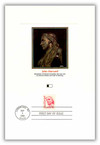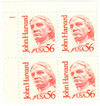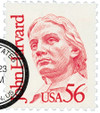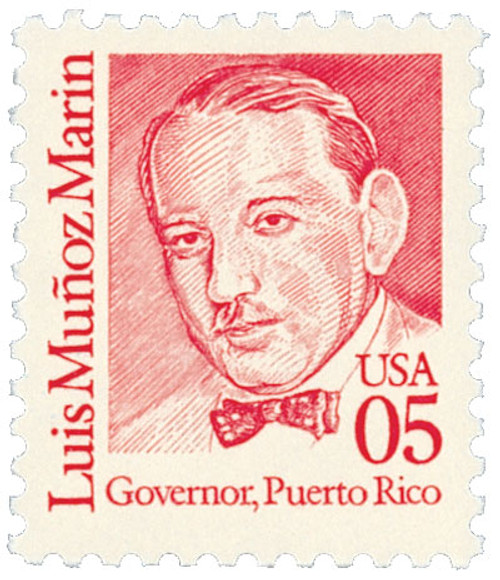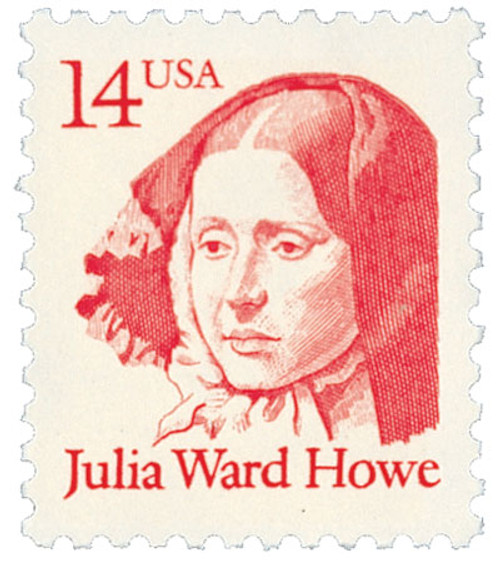
# 2190 - 1986 56¢ Great Americans: John Harvard
U.S. #2190
1986 56¢ John Harvard
Great Americans
- First stamp issued to pay the first-class three-ounce rate
- Stamp issued for the 350th anniversary of Harvard University
- Harvard is the earliest person pictured in the series, born in 1607
Stamp Category: Definitive
Series: Great Americans
Value: 56¢, the rate for three-ounce first-class letters
First Day of Issue: September 3, 1986
First Day City: Cambridge, Massachusetts
Quantity Issued: 53,150,000
Printed by: Bureau of Engraving and Printing
Printing Method: Engraved
Format: Panes of 100 in sheets of 800
Perforations: 11.2
Color: Scarlet
Why the stamp was issued: This was the first stamp to pay the rate for three-ounce first-class letters. Many Harvard University alumni had been pressing the USPS to issue a stamp to celebrate the institution’s 350th anniversary in 1986. However, since 1968, the postal service had prohibited the creation of stamps honoring individual schools. (Though they issued the 1985 Public Education stamp for the 350th anniversary of Boston Latin School, with no mention of the school in the stamp’s design.). The USPS found a compromise with this stamp, featuring the school’s namesake in the Great Americans Series.
About the stamp design: Robert Anderson based his stamp portrait on the 1884 seated statue of John Harvard by Daniel Chester French, which sits in front of the administration building in the Harvard yard. When French made his statue, there were no images of Harvard to base it on, so he modeled the statue’s face after Harvard student Sherman Hoar, a descendant of one of the school’s early presidents.
First Day City: The First Day ceremony for this stamp was held at the John F. Kennedy School of Government at Harvard University. The stamp ceremony marked the start of a five-day celebration of the school’s 350th anniversary.
About the Great Americans Series: The Great Americans Series was created to replace the Americana Series. The new series would be characterized by a standard definitive size, simple design, and monochromatic colors.
This simple design included a portrait, “USA,” the denomination, the person’s name, and in some cases, their occupation or reason for recognition. The first stamp in the new series was issued on December 27, 1980. It honored Sequoyah and fulfilled the new international postcard rate that would go into effect in January 1981.
The Great Americans Series would honor a wider range of people than the previous Prominent Americans and Liberty Series. While those series mainly honored presidents and politicians, the Great Americans Series featured people from many fields and ethnicities. They were individuals who were leaders in education, the military, literature, the arts, and human and civil rights. Plus, while the previous series only honored a few women, the Great Americans featured 15 women. This was also the first definitive series to honor Native Americans, with five stamps.
The Bureau of Engraving and Printing (BEP) produced most of the stamps, but private firms printed some. Several stamps saw multiple printings. The result was many different varieties, with tagging being the key to understanding them. Though there were also differences in perforations, gum, paper, and ink color.
The final stamp in the series was issued on July 17, 1999, honoring Justin S. Morrill. Spanning 20 years, the Great Americans was the longest-running US definitive series. It was also the largest series of face-different stamps, with a total of 63.
Click here for all the individual stamps and click here for the complete series.
History the stamp represents: Clergyman John Harvard is believed to have been born on November 26, 1607, in Southward, Surrey, England. Upon his death, Harvard donated half his fortune and his entire library to the school that was then named in his honor.
Harvard’s exact birth date is unknown, but it is often considered to be November 26, a few days before he was christened on November 29. Harvard was the fourth of nine children, and his grandfather was reportedly an associate of Shakespeare’s father. The bubonic plague later claimed the lives of most of Harvard’s family, leaving just him, a brother, and his mother. Harvard went on to attend the University of Cambridge and Emmanuel College where he earned a BA and MA and was eventually ordained a dissenting minister (English Dissenters were Protestants who had separated from the Church of England because they opposed government interference in religious matters). Harvard was married in 1636, and the following year moved with his wife to New England.
The Harvards settled in Charlestown, the oldest neighborhood in Boston, Massachusetts, and Harvard became a teaching elder of the First Church and an assistant preacher. Also while in Charlestown, Harvard was made part of a committee “to consider of some things tending toward a body of laws.” He had a home with 120 acres that he intended to use to raise cattle. However, Harvard would not get a chance to carry out this plan. He died of consumption, now known as tuberculosis, on September 14, 1638.
Two years before Harvard died, the Massachusetts Bay Colony established a college in what was then called Newtowne (later Cambridge) to “advance learning and perpetuate it to posterity: dreading to leave an illiterate ministry to the churches, when our present ministers shall lie in the dust.”
Over his lifetime, Harvard had inherited a significant amount of money following the deaths of his parents and brother. Having no children, he told his wife on his deathbed that he wished to donate half of his estate (£780 – worth over $165,000 today) to the young school, and she would receive the other half. Harvard’s donation to the school nearly equaled the Massachusetts Bay Colony’s annual tax receipts. Harvard also bequeathed his 400-volume library to the school. Unfortunately, all but one of these books was destroyed in a fire in 1764.
Although Harvard wasn’t instrumental in founding the college, his bequests of half his estate and his 400-volume library nearly doubled the school’s resources. In recognition of Harvard’s significant contribution to the school, it was renamed in his honor in 1639.
In 1884, sculptor Daniel Chester French unveiled a seated statue of Harvard that resides at Harvard Yard, the oldest part of the campus. There were no images of Harvard to base it on, so French modeled the statue’s face after Harvard student Sherman Hoar, a descendant of one of the school’s early presidents. There’s an interesting custom surrounding the statue. Visitors and graduating students rub the toe of Harvard’s left shoe for luck. As a result, that part of the statue is brighter than the rest.
There’s also a John Harvard library in Southward Lindon, a Harvard Bridge connecting Boston to Cambridge, and Harvard Chapel in Southward Cathedral.
U.S. #2190
1986 56¢ John Harvard
Great Americans
- First stamp issued to pay the first-class three-ounce rate
- Stamp issued for the 350th anniversary of Harvard University
- Harvard is the earliest person pictured in the series, born in 1607
Stamp Category: Definitive
Series: Great Americans
Value: 56¢, the rate for three-ounce first-class letters
First Day of Issue: September 3, 1986
First Day City: Cambridge, Massachusetts
Quantity Issued: 53,150,000
Printed by: Bureau of Engraving and Printing
Printing Method: Engraved
Format: Panes of 100 in sheets of 800
Perforations: 11.2
Color: Scarlet
Why the stamp was issued: This was the first stamp to pay the rate for three-ounce first-class letters. Many Harvard University alumni had been pressing the USPS to issue a stamp to celebrate the institution’s 350th anniversary in 1986. However, since 1968, the postal service had prohibited the creation of stamps honoring individual schools. (Though they issued the 1985 Public Education stamp for the 350th anniversary of Boston Latin School, with no mention of the school in the stamp’s design.). The USPS found a compromise with this stamp, featuring the school’s namesake in the Great Americans Series.
About the stamp design: Robert Anderson based his stamp portrait on the 1884 seated statue of John Harvard by Daniel Chester French, which sits in front of the administration building in the Harvard yard. When French made his statue, there were no images of Harvard to base it on, so he modeled the statue’s face after Harvard student Sherman Hoar, a descendant of one of the school’s early presidents.
First Day City: The First Day ceremony for this stamp was held at the John F. Kennedy School of Government at Harvard University. The stamp ceremony marked the start of a five-day celebration of the school’s 350th anniversary.
About the Great Americans Series: The Great Americans Series was created to replace the Americana Series. The new series would be characterized by a standard definitive size, simple design, and monochromatic colors.
This simple design included a portrait, “USA,” the denomination, the person’s name, and in some cases, their occupation or reason for recognition. The first stamp in the new series was issued on December 27, 1980. It honored Sequoyah and fulfilled the new international postcard rate that would go into effect in January 1981.
The Great Americans Series would honor a wider range of people than the previous Prominent Americans and Liberty Series. While those series mainly honored presidents and politicians, the Great Americans Series featured people from many fields and ethnicities. They were individuals who were leaders in education, the military, literature, the arts, and human and civil rights. Plus, while the previous series only honored a few women, the Great Americans featured 15 women. This was also the first definitive series to honor Native Americans, with five stamps.
The Bureau of Engraving and Printing (BEP) produced most of the stamps, but private firms printed some. Several stamps saw multiple printings. The result was many different varieties, with tagging being the key to understanding them. Though there were also differences in perforations, gum, paper, and ink color.
The final stamp in the series was issued on July 17, 1999, honoring Justin S. Morrill. Spanning 20 years, the Great Americans was the longest-running US definitive series. It was also the largest series of face-different stamps, with a total of 63.
Click here for all the individual stamps and click here for the complete series.
History the stamp represents: Clergyman John Harvard is believed to have been born on November 26, 1607, in Southward, Surrey, England. Upon his death, Harvard donated half his fortune and his entire library to the school that was then named in his honor.
Harvard’s exact birth date is unknown, but it is often considered to be November 26, a few days before he was christened on November 29. Harvard was the fourth of nine children, and his grandfather was reportedly an associate of Shakespeare’s father. The bubonic plague later claimed the lives of most of Harvard’s family, leaving just him, a brother, and his mother. Harvard went on to attend the University of Cambridge and Emmanuel College where he earned a BA and MA and was eventually ordained a dissenting minister (English Dissenters were Protestants who had separated from the Church of England because they opposed government interference in religious matters). Harvard was married in 1636, and the following year moved with his wife to New England.
The Harvards settled in Charlestown, the oldest neighborhood in Boston, Massachusetts, and Harvard became a teaching elder of the First Church and an assistant preacher. Also while in Charlestown, Harvard was made part of a committee “to consider of some things tending toward a body of laws.” He had a home with 120 acres that he intended to use to raise cattle. However, Harvard would not get a chance to carry out this plan. He died of consumption, now known as tuberculosis, on September 14, 1638.
Two years before Harvard died, the Massachusetts Bay Colony established a college in what was then called Newtowne (later Cambridge) to “advance learning and perpetuate it to posterity: dreading to leave an illiterate ministry to the churches, when our present ministers shall lie in the dust.”
Over his lifetime, Harvard had inherited a significant amount of money following the deaths of his parents and brother. Having no children, he told his wife on his deathbed that he wished to donate half of his estate (£780 – worth over $165,000 today) to the young school, and she would receive the other half. Harvard’s donation to the school nearly equaled the Massachusetts Bay Colony’s annual tax receipts. Harvard also bequeathed his 400-volume library to the school. Unfortunately, all but one of these books was destroyed in a fire in 1764.
Although Harvard wasn’t instrumental in founding the college, his bequests of half his estate and his 400-volume library nearly doubled the school’s resources. In recognition of Harvard’s significant contribution to the school, it was renamed in his honor in 1639.
In 1884, sculptor Daniel Chester French unveiled a seated statue of Harvard that resides at Harvard Yard, the oldest part of the campus. There were no images of Harvard to base it on, so French modeled the statue’s face after Harvard student Sherman Hoar, a descendant of one of the school’s early presidents. There’s an interesting custom surrounding the statue. Visitors and graduating students rub the toe of Harvard’s left shoe for luck. As a result, that part of the statue is brighter than the rest.
There’s also a John Harvard library in Southward Lindon, a Harvard Bridge connecting Boston to Cambridge, and Harvard Chapel in Southward Cathedral.





